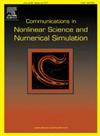简化微柱模型中内部因素对两两直连神经元峰列相关的影响
IF 3.8
2区 数学
Q1 MATHEMATICS, APPLIED
Communications in Nonlinear Science and Numerical Simulation
Pub Date : 2025-06-25
DOI:10.1016/j.cnsns.2025.109079
引用次数: 0
摘要
大脑皮层成对神经元的突列相关性与认知能力密切相关。目前,对脉冲序列相关的内部影响机制,特别是对成对直连神经元的影响机制还有待进一步研究。为此,本文在微柱(micro-column, MC)模型中探讨了内部因素对成对直连神经元突列相关的影响。具体而言,首先构建具有形态学的简化MC模型,然后设置两组参数,分别得到两个特定的MC,分别称为MC1和MC2,其中重点关注MC中的两个输出神经元(分别称为PN4和PN5)。此外,本文还提出了一个尖峰数相似度(SCS)度量和一个尖峰时间相关度(STC)度量来量化特定的零滞后尖峰序列相关模式。主要模拟结果表明,内部因素(包括突触强度、突触延迟以及体细胞和轴突丘的体积)的变化在不同程度上影响了突列相关性,由此推断直连神经元的突列相关性可以被这些内部因素有效地调节。这进一步表明,与抑制性突触相比,兴奋性突触的存在可能是峰列出现极高相关性的必要条件。在一个特定的范围内,SCS测量是一个关于抑制性突触强度的递减函数和一个关于兴奋性突触强度的递增函数。此外,PN4体细胞体积越大,STC越弱。相对于胞体和轴突丘体积的变化,STC指标对突触强度和突触延迟的变化更为敏感。与现有模型不同的是,本文构建的神经网络模型充分考虑了神经元形态(如树突分支)对神经网络内在/动态行为的影响。此外,所建立的MC模型将为研究多个神经元之间的高阶尖峰序列相关性提供基础。本文提出的两个指标为分析成对尖峰序列的相关强度提供了一个新的视角。此外,它们还可以用来识别某些特殊的尖峰序列相关模式,这些模式可能在未来为脑机接口提供一些有用的解码策略。本文章由计算机程序翻译,如有差异,请以英文原文为准。
Effect of the internal factors on the spike train correlation of pairwise directly connected neurons in a simplified micro-column model
The spike train correlation of pairwise neurons in the cerebral cortex is tightly related to cognitive abilities. Nowadays, more clarity is needed on the internal influencing mechanism of spike train correlation, especially in pairwise directly connected neurons. To this end, this paper explores effect of the internal factors on the spike train correlation of pairwise directly connected neurons in a micro-column (MC) model. In detail, a simplified MC model with morphology is constructed, then two groups of parameters are set to obtain two specific MCs called MC1 and MC2 respectively, where two output neurons (named as PN4 and PN5 separately) in the MCs are focused on. What is more, a spike count similarity (SCS) metric and a spike time correlation (STC) metric are proposed in this paper to quantify specific spike train correlation patterns with zero time lag. The main simulation results demonstrate that variations of the internal factors (including the synaptic strengths, the synaptic delay, as well as volumes of the soma and axon hillock) affect the spike train correlation to different extents, from which it is inferred that the spike train correlation of directly connected neurons could be effectively modulated by these internal factors. It is further shown that, compared to the inhibitory synapse, existence of the excitatory synapse may be necessary for the appearance of extremely high correlation for spike trains. In a specific range, the SCS metric is a decreasing function concerning the strength of the inhibitory synapse and an increasing function with respect to the strength of the excitatory synapse. In addition, a larger soma volume of PN4 corresponds to a weaker STC. Compared with variations of the volumes concerning the soma and axon hillock, the STC metric is more sensitive to the changes in the synaptic strengths as well as synaptic delays. Unlike the existing ones, the MC model constructed in this paper fully considers the neuronal morphology (such as the dendritic branches) which shapes the intrinsic/dynamical behaviors of the MCs. Furthermore, this established MC model would provide a foundation for investigating the higher-order spike train correlations among multiple neurons. The two metrics proposed here present a novel perspective for analyzing the correlation strength of pairwise spike trains. Also, they can be used to identify certain special spike train correlation patterns that might provide some helpful decoding strategies in the brain computer interface in the future.
求助全文
通过发布文献求助,成功后即可免费获取论文全文。
去求助
来源期刊

Communications in Nonlinear Science and Numerical Simulation
MATHEMATICS, APPLIED-MATHEMATICS, INTERDISCIPLINARY APPLICATIONS
CiteScore
6.80
自引率
7.70%
发文量
378
审稿时长
78 days
期刊介绍:
The journal publishes original research findings on experimental observation, mathematical modeling, theoretical analysis and numerical simulation, for more accurate description, better prediction or novel application, of nonlinear phenomena in science and engineering. It offers a venue for researchers to make rapid exchange of ideas and techniques in nonlinear science and complexity.
The submission of manuscripts with cross-disciplinary approaches in nonlinear science and complexity is particularly encouraged.
Topics of interest:
Nonlinear differential or delay equations, Lie group analysis and asymptotic methods, Discontinuous systems, Fractals, Fractional calculus and dynamics, Nonlinear effects in quantum mechanics, Nonlinear stochastic processes, Experimental nonlinear science, Time-series and signal analysis, Computational methods and simulations in nonlinear science and engineering, Control of dynamical systems, Synchronization, Lyapunov analysis, High-dimensional chaos and turbulence, Chaos in Hamiltonian systems, Integrable systems and solitons, Collective behavior in many-body systems, Biological physics and networks, Nonlinear mechanical systems, Complex systems and complexity.
No length limitation for contributions is set, but only concisely written manuscripts are published. Brief papers are published on the basis of Rapid Communications. Discussions of previously published papers are welcome.
 求助内容:
求助内容: 应助结果提醒方式:
应助结果提醒方式:


